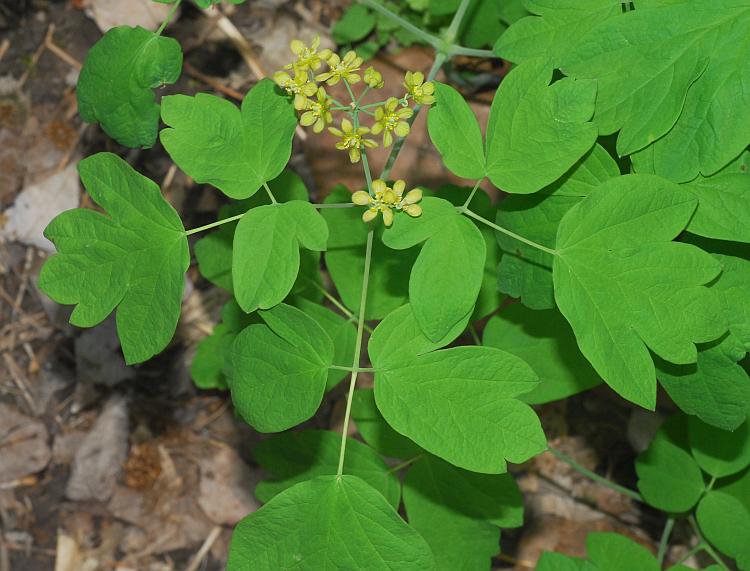Caulophyllum thalictroides (L.) Michx.
Blue Cohosh

Native
CC = 8
CW = 5
MOC = 39
© SRTurner
Caulophyllum thalictroides (L.) Michx.Blue Cohosh | |
 |
Native CC = 8 CW = 5 MOC = 39 |
© SRTurner |
|
Family - Berberidaceae Habit - Rhizomatous perennial herb. Stems - Ascending to erect, to 60 cm, strongly glaucous, terete, green with purple at the base, glabrous.
Leaves - Usually two per stem. Lower leaf 3 times ternately compound, 20-32 cm long, usually sessile, occasionally with a petiole to 4.5 cm long; upper leaf twice ternate, 8.5-14.0 cm long. Leaflets 3(4-5)-lobed at the apex, entire, glabrous, 4-5 cm long, 3 cm broad. Lobes of the leaflets acute, with a small whitish apex. Main veins of the leaflets arising from the base of the leaflet. All veins impressed above, expressed below. Lateral leaflets often oblique at the base.
Inflorescence - Terminal panicles to 6 cm long, with 4-16 flowers. Peduncle to 3 cm long, glabrous. Each division of the panicle subtended by a minute bract, these 1-2 mm long, acute, scarious on the margins. Flowers immediately subtended by 3-4 sepal-like bractlets.
Flowers - Petaloid sepals 6, yellow-green, spatulate, rounded at the apex, 5 mm long, 2-3 mm broad, with slightly darker veins, distinct. Petals much smaller than the sepals, green, glabrous, hooded, 2 mm long, 2 mm broad at the apex. Stamens 6, ascending. Filaments green, glabrous, 1.5 mm long. Anthers yellow, 1 mm long, 1 mm broad, bi-lobed. Ovary green, obovoid, glabrous, 2 mm long, 2 mm broad, slightly 3-sided, unilocular, with 3 ovules, tapering into a 1 mm long style. Stigma minute. Placentation basal.
Fruits - Fruit wall rupturing early in development to expose the developing seeds. Seeds 1 or 2 per fruit, 6-9 mm long, spherical, each on a thick stalk 4-7 mm long, the seed coat fleshy, blue, glaucous.
Flowering - March - May. Habitat - Mesic and bottomland forests, rich wooded ravines, north-facing wooded slopes, moist base of bluffs. Origin - Native to the U.S. Lookalikes - None. Other info. - This species can be found scattered throughout most of Missouri but is not particularly common. Its U.S. distribution includes most of the upper Midwest and New England, and also extends into Canada. It is easily identified in the field by its glaucous stems, ternately divided leaves, and yellow-green flowers. If the plants are in fruit, the brilliant blue seeds are unmistakable. The plant is an indicator of relatively undisturbed habitat. Photographs taken at Earthquake Hollow Conservation Area, Callaway County, MO., 4-13-04 (DETenaglia); also at Weldon Spring Conservation Area, St. Charles County, MO, 4-17-2016, and Crawford Estate Conservation Area, Clark County, MO, 7-8-2017 (SRTurner). |